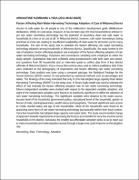| dc.description.abstract | ARINAITWE KAMBAMU LYDIA (2011-M152-20025)
Factors Affecting Rain Water Harvesting Technology Adoption: A Case of Mitooma District
Access to safe water for all people is one of the millennium development goals (Millennium declaration, 2000). In rural areas, however, it has not been easy for most households to achieve it; yet rain water harvesting technology has the potential of providing clean and safe water to households at a low or no cost at all. In Mitooma district, however, rain water harvesting is being practiced at a low rate, leading to insufficient availability of clean water for domestic use for many households. The aim of the study was to establish the factors affecting rain water harvesting technology adoption among households in Mitooma district. Specifically, the study looked at the rate of adoption, factors affecting adoption and evaluation of the factors affecting adoption of rain water harvesting technology. Purposive and convenience sampling were employed to select the study sample. Quantitative data were collected using questionnaires with both open and closed-end questions from 90 households and an interview guide to collect data from 5 key district officials of Mitooma District. Focus Group Discussions were used to collect qualitative data. Data were collected on the demography of respondents and factors affecting rain water harvesting technology. Data analysis was done using a computer package, the Statistical Package for the Social Sciences (SPSS) version 16 and presented by statistical methods such as percentages and tables. The findings of the study indicated that only 0.12% had adopted large capacity Rain Water Harvesting Technology (RWHT) in the study area. A binary logit model was used to estimate the effect of and evaluate the factors affecting adoption rate of rain water harvesting technology. Eleven independent variables were studied with respect to the dependent variable, adoption; and eight of the independent variables were found to be positively significant to affect the adoption of rain water harvesting technology. The significant variables were distance to the water source, income level of the household, government policy, educational level of the household, gender in favour of male, training/awareness, wealth status and topography. The least significant were access to credit, marital status and age of the householder. Most of the households were found to be practicing some form of rain water harvesting technology but basically within their local context. Very few households had adopted large capacity rain water tanks. The study recommended change of approach towards requirements of accessing the fund so as to benefit the very low-income earner households in the district. Advocacy for smaller but affordable rainwater tanks so as to reach out to many households and make adoption spread through a larger area could improve on the adoption rate.
Harvesting, Rain, Technology, Adoption | en_US |


